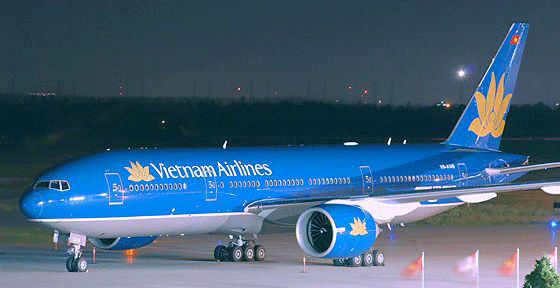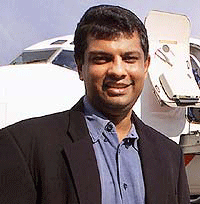Asia-Pacific Air Cargo Trends 2007

International
cargo across the Asia Pacific region is expected to lead global freight
growth at an annual rate (AAGR) of 6.0 % during 2007 International Air
Transport Association (IATA) predicts.
Asian airlines are forecast to make $1.2
billion in aggregate profits in 2007, down from an estimated 1.7 delivered
in 2006.
Competition, more capacity and new entrants
will impact bottom lines IATA said.
IATA also reports seven of the top 10 freight
markets fall within the Asia Pacific region with China's freight AAGR
forecast at 11.6 pct from 2006 to 2010, followed by Pakistan at 8.8 %,
Korea 8.2 %, India %, Sri Lanka 7.4, Thailand 6.3 % and Indonesia 5.8
%.
For Australia, IATA puts freight traffic
AAGR growth at about 4.4 percent.
 As
to new carriers homing in on the already crowded skies above Asia, Andrew
Pyne, CEO of newcomer Viva Macau, which launched services from Macau to
Jakarta and the Maldives with two B767 aircraft, may have coined a new
word to describe future carriers telling a CAPA conference audience last
November that Viva Macau operates a “fusion airline” model. As
to new carriers homing in on the already crowded skies above Asia, Andrew
Pyne, CEO of newcomer Viva Macau, which launched services from Macau to
Jakarta and the Maldives with two B767 aircraft, may have coined a new
word to describe future carriers telling a CAPA conference audience last
November that Viva Macau operates a “fusion airline” model.
The carrier utilizes widebody aircraft allowing
for operations to medium-to-long-haul routes (services to Europe, Australia
and the Middle East are planned) because of their cargo capabilities.
“We anticipate a predatory response
from the immediate region’s established carriers,” Mr. Pyne
said.
“Cargo – which we ultimately
anticipate accounting for 23% of revenues – provides a cushion to
help us withstand that.”
To be sure there is no lack of carriers
wanting in on Asia/Pacific action.
AirAsia, the budget carrier launched five
years ago with two aircraft, now says it could be bigger than Singapore
Airlines and Cathay Pacific by the end of 2007.
 Tony
Fernandes, colorful self-assured founder of the Malaysia-based airline
made the claim last year as he purchased 50 medium-range Airbus A320 jets
with options on 50 more. Tony
Fernandes, colorful self-assured founder of the Malaysia-based airline
made the claim last year as he purchased 50 medium-range Airbus A320 jets
with options on 50 more.
"I'd imagine we'd be the largest airline
in Asia by passenger size by 2013 or 2014, he told a reporter.
"In fact by next year, we could be
bigger than Singapore Airlines and Cathay Pacific in terms of passenger
carriage."
Whether or not Fernandes had to tell his
investors the same thing to get an OK to buy the airplanes remains to
be discovered.
The point is, one way or another business
as usual will be unusual from now on across the region.
Fernandes said AirAsia X would take off this July with flights to the
UK at initial fares of 9.99 rgt, or less than $3USD.
Elsewhere according to numbers crunchers
Brian Clancy and David Hoppin, all Asian markets will enjoy steady and
gently accelerating growth between 2006 and 2010.
“The main driver of rising freight
demand will be sustained economic growth in the main consuming countries
of North America, Europe and Japan.
“An additional demand driver will
be the progressive “off-shoring” of increasingly sophisticated
industrial goods production from North America and Europe to Asia.
“Finally, persistent congestion and
delay problems in the containerized ocean transport system will force
planned and “emergency” upgrades from sea to air freight.
“Consistent with historical patterns,
the majority of new traffic (absolute growth in annual tonnage from 2007
to 2010) will be generated in intra-Asia and Asia export trades.
“The geographic concentration of new
traffic reflects the size of Asian air freight markets relative to other
intercontinental air freight flows.
“Asian producers are pushing into
capital equipment, which will be the fastest-growing commodity type over
the next five years,” Mr. Clancy said.
Asian exports of capital equipment, both
to other Asian countries as well as to North America and Europe, will
account for more than half of forecast new traffic.
China's gross domestic product grew 10.5
percent in 2006, after GDP growth of 10.2 percent in 2005.
But government efforts to cool the economy
are falling short, in part because out in the country, the trend is to
ignore proclamations from Beijing.
So as China adjusts to a unique form of
capitalist/communism the world’s most populous country has more
rich and poor and emerging markets than anyone.
Hope springs eternal (at least in USA) that
Vietnam gaining entrance into the World Trade Organization may mean less
pirating of Hollywood movies, but no doubt WTO also will nudge the so-called
“bread basket of Asia” Tiger, to play the world trade business
game straighter.
Busy buying Boeings and Airbuses, Vietnam
Airlines just took delivery of the first of 10 new Airbus A321 passenger
jets that arrived at Noi Bai International Airport on Thursday January
11, 2007.
Having achieved normal-trade-relations with
the United States, Vietnam will continue to emerge on the world airline
and business stage having netted 8% growth last year.
Japan having popped out from its post-bubble
burst intact and on the upswing for the past few years, is still the world's
second-largest economy.
Projecting a 2 % growth rate in 2007, Japan
wants to buy companies in China and elsewhere particularly in Korea and
Asia.
But memories run deep and people apparently
will not forget the horror Japan inflicted on China and Korea during the
1940’s.
Speaking of South Korea, with annual 4 percent
to 5 percent GDP growth, and Hyundai probably even making toothpaste,
South Korea will ink a pact for free-trade with Washington this year.
But imagine what Korea might do finally
striking some kind of accord toward a Greater Korea, by getting those
grumpy North Koreans to come off the belligerent stuff that threatens
the region and maybe the world?
(Geoffrey, Patrick Burnson contributed to this story)
|



